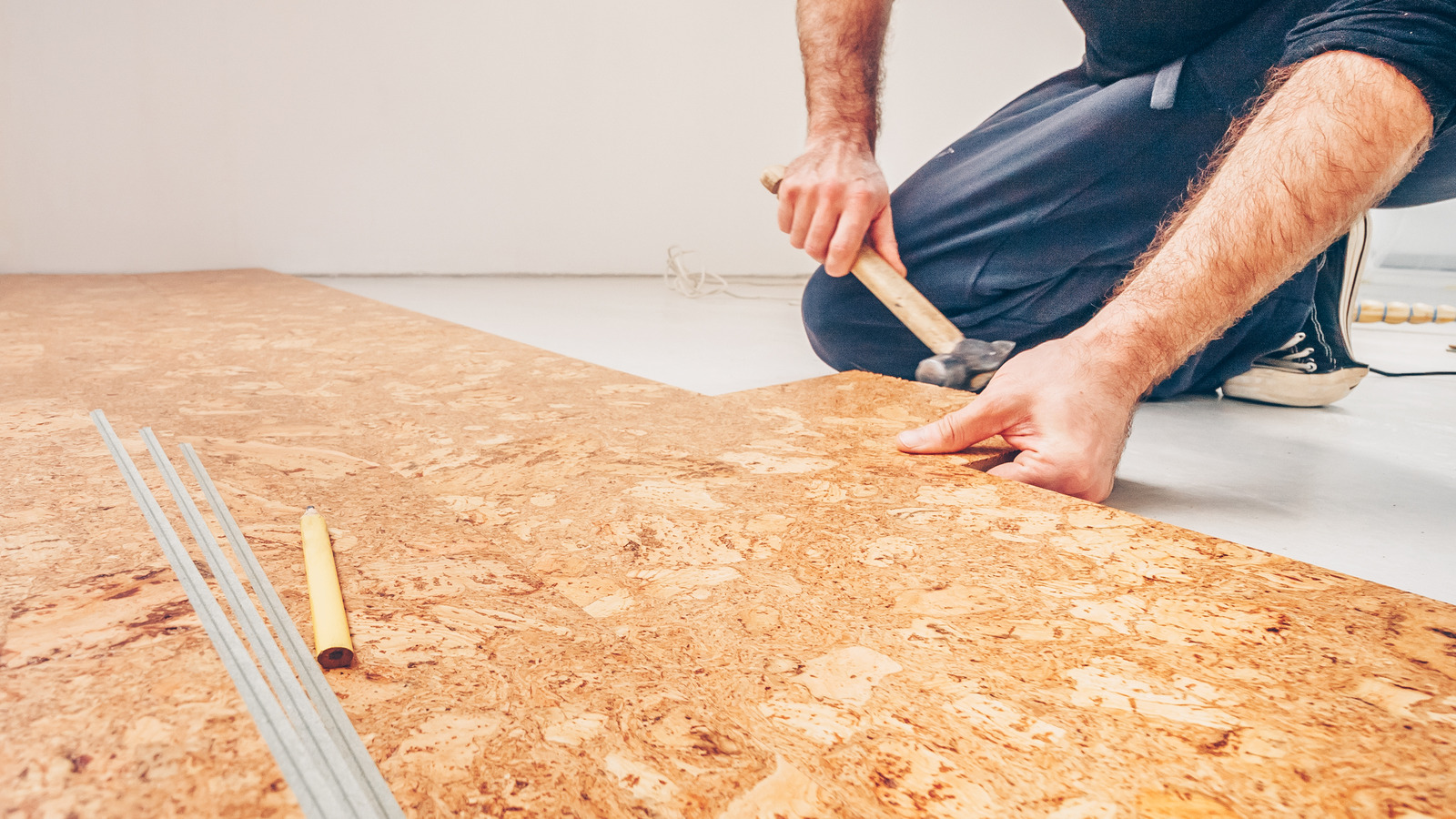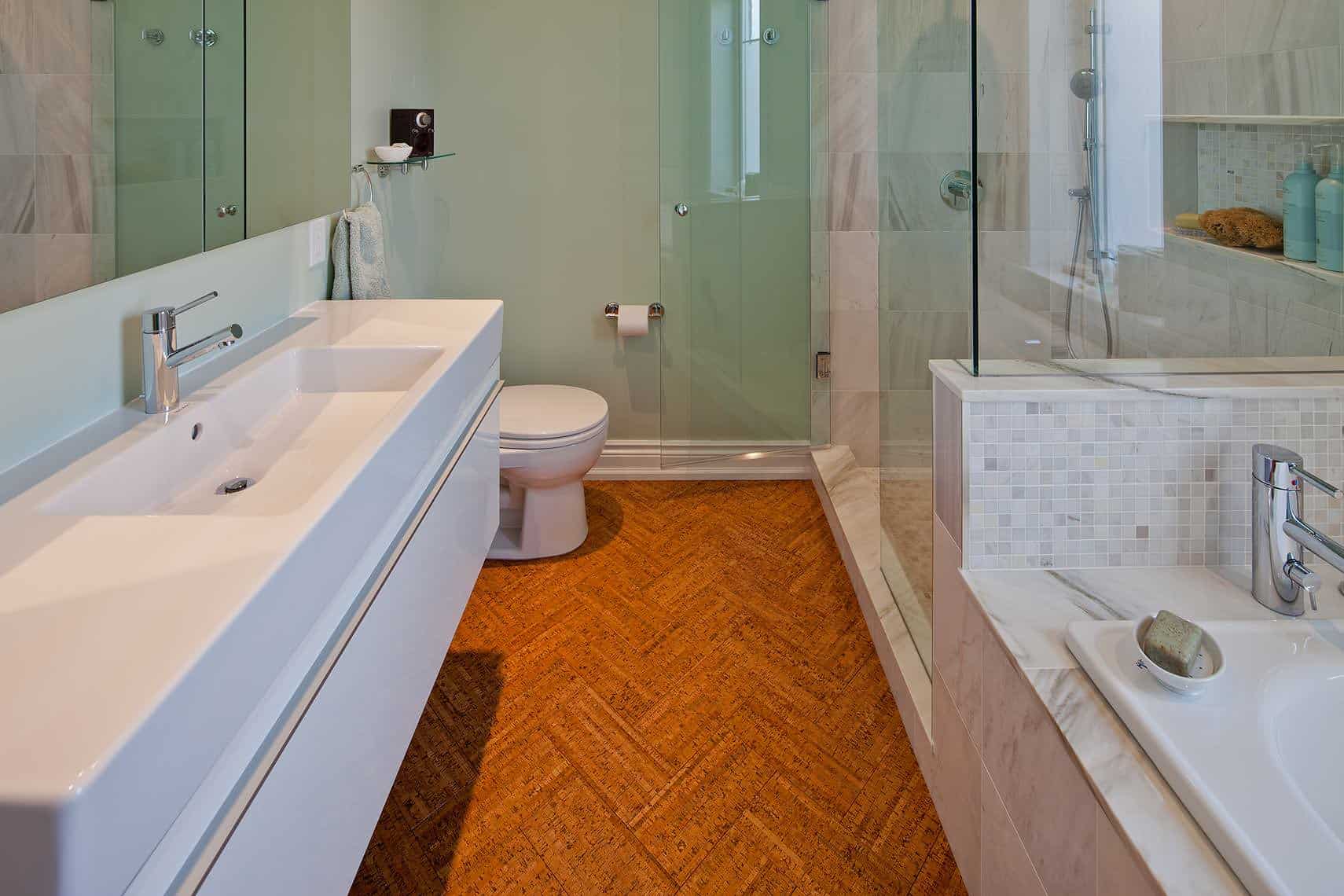Floating Cork Floor Advantages in Bathrooms

Floating cork flooring offers a unique blend of practicality and aesthetics, making it an excellent choice for bathroom spaces. Its inherent water resistance, sound absorption properties, and natural comfort contribute to a functional and inviting environment.
Water Resistance and Durability of Cork Flooring
Cork flooring’s inherent water resistance stems from its natural composition. Cork is harvested from the bark of the cork oak tree, and its cellular structure contains air pockets that repel water. This natural water resistance makes it suitable for bathrooms, where moisture is prevalent. While cork flooring is inherently water-resistant, it’s essential to seal it with a water-based sealant to enhance its protection against moisture and spills.
Cork Flooring Durability Compared to Other Bathroom Flooring Options
Cork flooring’s durability is comparable to other bathroom flooring options like tile, vinyl, and laminate. It can withstand moderate foot traffic and resist scratches and dents, making it a suitable choice for bathrooms.
- Tile: Tile is known for its durability and resistance to water, making it a popular choice for bathrooms. However, tile can be cold and hard underfoot, and its installation can be more complex and costly.
- Vinyl: Vinyl flooring is affordable and water-resistant, making it a viable option for bathrooms. However, it may not be as durable as tile or cork and can be susceptible to scratches and dents.
- Laminate: Laminate flooring is a cost-effective alternative to hardwood, offering water resistance and durability. However, laminate can be less comfortable underfoot than cork and may not be as aesthetically pleasing.
Cork Flooring’s Sound Absorption and Comfort
Cork flooring excels in sound absorption, offering a quieter and more comfortable environment compared to other bathroom flooring options. The natural cellular structure of cork effectively reduces noise transmission, making it ideal for bathrooms where soundproofing is essential.
Bathroom Design with Floating Cork Flooring
Floating cork flooring’s warm, natural tones and soft texture create a welcoming atmosphere in bathrooms. Its versatility allows for various design styles, from minimalist to rustic. The warm, earthy tones of cork flooring complement a range of bathroom fixtures and accessories, adding a touch of elegance and sophistication.
“Cork flooring can be a great option for bathrooms, as it is water-resistant, durable, and comfortable underfoot. It also has a natural warmth that can make a bathroom feel more inviting.” – [Source: Flooring Experts]
Installation and Maintenance of Floating Cork Flooring in Bathrooms

Floating cork flooring installation in bathrooms is a straightforward process that involves laying the planks over a moisture-resistant underlayment. This method allows for easy expansion and contraction of the flooring due to humidity changes, preventing warping or buckling.
Installation Process
The installation process of floating cork flooring in bathrooms involves several steps, ensuring proper preparation and execution for a long-lasting and aesthetically pleasing result.
- Prepare the Subfloor: The subfloor must be level, clean, and free of debris. Any cracks or gaps should be repaired using a suitable patching compound. For bathrooms, a moisture-resistant underlayment is crucial. This underlayment acts as a barrier against moisture, protecting the cork flooring from water damage.
- Lay the Underlayment: Install the moisture-resistant underlayment over the prepared subfloor. The underlayment should be cut to fit the bathroom space and secured using staples or tape. Ensure the underlayment is smooth and free of wrinkles or gaps.
- Start Installation: Begin laying the cork planks from one wall, leaving an expansion gap of approximately 1/4 inch around the perimeter of the room. This gap allows for the natural expansion and contraction of the flooring due to temperature and humidity fluctuations.
- Join the Planks: Use a tapping block and mallet to gently tap the planks together, creating a tight and secure fit. Ensure the planks are aligned and flush with each other.
- Cut and Install: Use a sharp utility knife or a jigsaw to cut the planks to fit around obstacles, such as toilets, sinks, or bathtubs. Carefully install the cut planks, ensuring they are properly secured and aligned.
- Secure the Flooring: Once all the planks are installed, use a trim molding to cover the expansion gap around the perimeter of the room. This molding not only provides a finished look but also helps to hold the flooring in place.
Cleaning and Maintenance, Floating cork floor bathroom
Maintaining floating cork flooring in bathrooms requires regular cleaning and proper care to prevent stains and water damage.
- Regular Cleaning: Sweep or vacuum the floor regularly to remove dirt and debris. For a deeper clean, use a damp mop with a mild cleaner specifically designed for cork flooring. Avoid using harsh chemicals or abrasive cleaners that can damage the finish.
- Water Damage Prevention: Cork is naturally porous, so it is important to address spills promptly. Blot up any spills immediately with a clean cloth or sponge. Avoid letting water sit on the floor for extended periods, as this can lead to warping or mold growth.
- Stain Removal: For stubborn stains, try using a mild soap and water solution. For more challenging stains, consult the manufacturer’s instructions for the specific cork finish. Avoid using harsh chemicals or abrasive cleaners that can damage the surface.
Cork Floor Finishes
Different cork floor finishes offer varying levels of durability, water resistance, and aesthetics, influencing their suitability for bathrooms.
| Finish Type | Durability | Water Resistance | Aesthetics |
|---|---|---|---|
| Polyurethane | High | Moderate | Natural look with a slight sheen |
| Wax | Moderate | Low | Matte finish, enhancing the natural cork texture |
| Oil | Moderate | Low | Natural look with a satin finish |
| Epoxy | High | High | Glossy finish, providing a durable and water-resistant surface |
Design Inspiration for Floating Cork Flooring in Bathrooms: Floating Cork Floor Bathroom
Floating cork flooring can add a touch of warmth, natural beauty, and elegance to any bathroom. Its versatility allows it to complement a wide range of design styles, from minimalist to traditional. This section explores various design inspirations, highlighting how floating cork flooring can be integrated into different bathroom settings.
Color Palette and Design Styles
The natural hues of cork flooring provide a neutral backdrop for various color palettes and design styles.
- Minimalist Bathrooms: Opt for a light-colored cork floor, such as a natural or whitewashed finish, to create a sense of spaciousness and serenity. Pair it with minimalist fixtures, white walls, and sleek accessories.
- Traditional Bathrooms: Darker shades of cork, such as brown or reddish tones, can complement traditional bathroom decor. Combine them with vintage fixtures, patterned tiles, and antique-inspired accessories.
- Contemporary Bathrooms: Cork flooring in a gray or charcoal shade can create a modern and sophisticated look. Pair it with geometric tiles, metallic accents, and contemporary lighting fixtures.
- Rustic Bathrooms: Embrace the natural warmth of cork by choosing a finish with a rustic look. Combine it with wood accents, exposed brick walls, and natural stone elements.
Complementing Design Elements
Cork flooring can be enhanced by incorporating various design elements that create a cohesive and stylish bathroom space.
- Wall Colors: Consider a soft, neutral color palette for the walls, such as white, beige, or light gray, to allow the natural beauty of the cork flooring to shine through. For a bolder statement, use contrasting colors, such as deep blues, greens, or grays, to create a focal point.
- Fixtures: Choose fixtures that complement the overall style of the bathroom and the color palette of the cork flooring. For example, sleek and modern fixtures can enhance a contemporary design, while antique-inspired fixtures can add charm to a traditional setting.
- Accessories: Use accessories to add personality and functionality to the bathroom. For example, incorporate woven baskets, plants, and decorative towels to enhance the natural ambiance of the cork flooring.
Maximizing Space and Functionality
Floating cork flooring can be used to create a functional and stylish bathroom, even in smaller spaces.
- Open Floor Plan: In smaller bathrooms, use a light-colored cork floor to create a sense of spaciousness and openness. Consider a floating vanity or a wall-mounted toilet to further enhance the feeling of space.
- Strategic Placement: Use cork flooring to visually separate different areas within a larger bathroom. For example, create a distinct zone for the shower or bathtub by using a different shade of cork flooring or a decorative border.
- Lighting: Maximize natural light by using windows or skylights. Supplement with strategically placed artificial lighting to create a warm and inviting ambiance.
